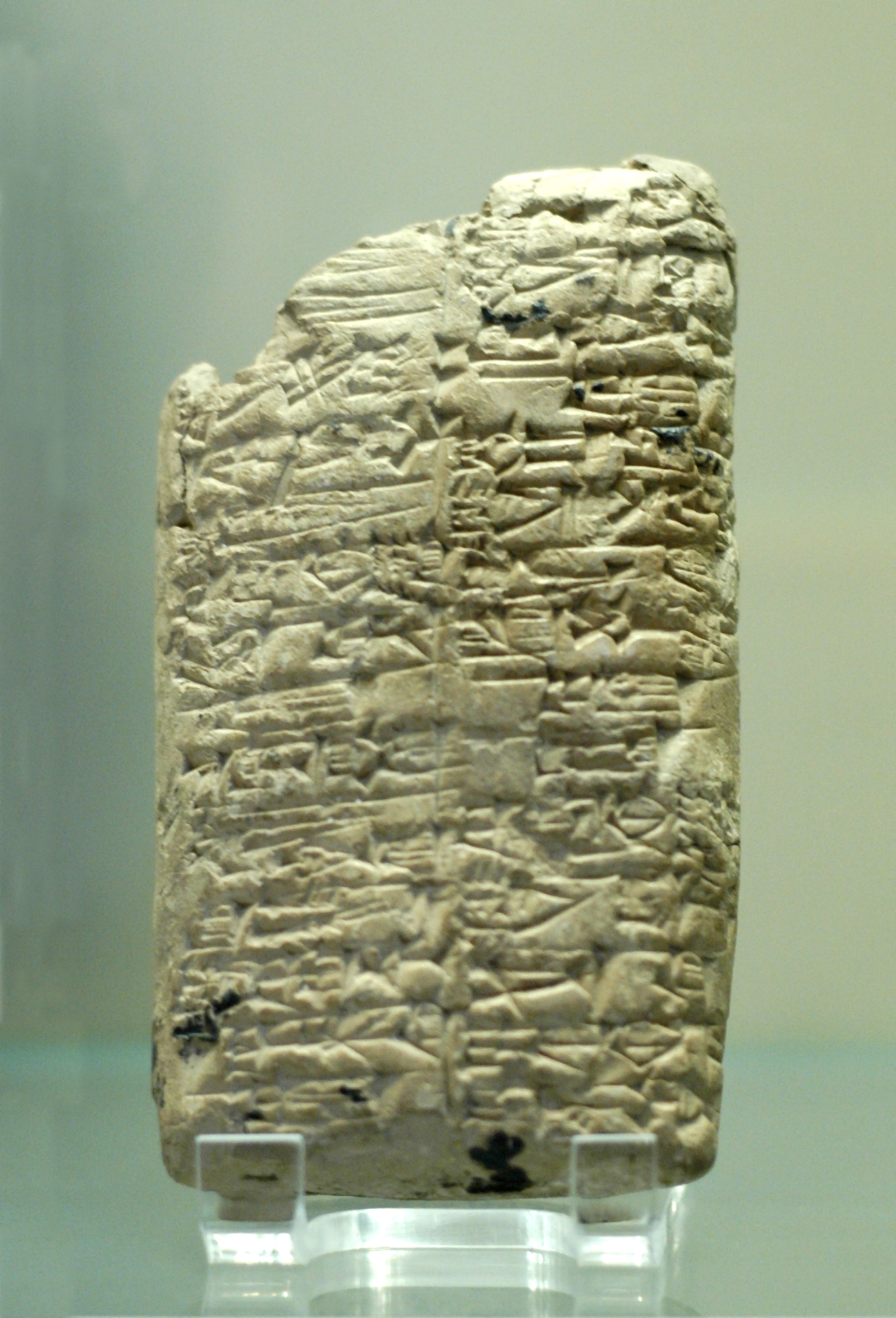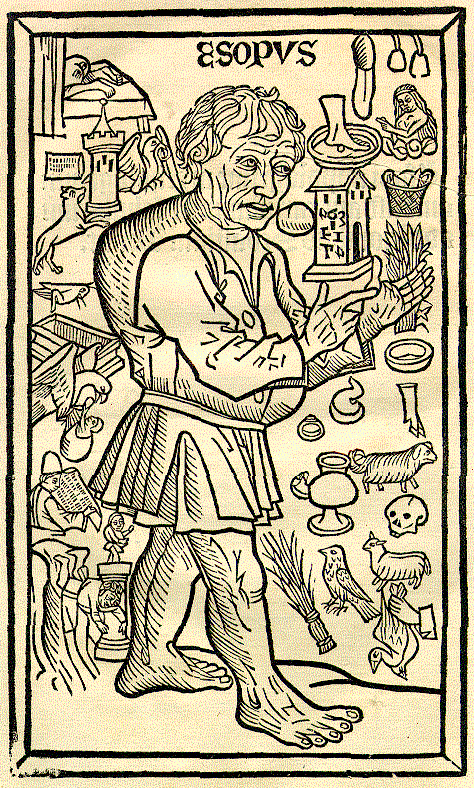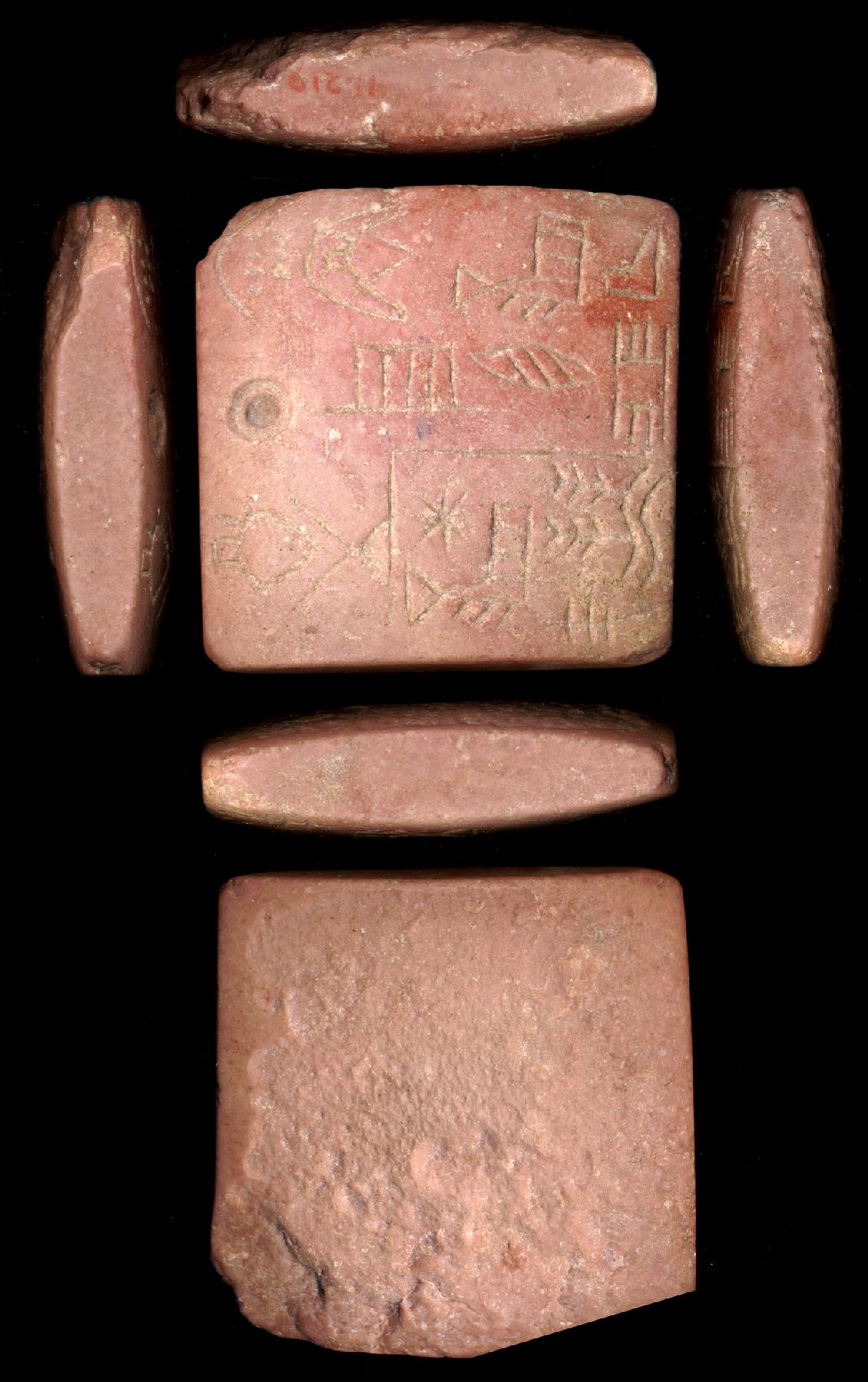|
Debate Between Tree And Reed
The Debate between tree and reed ( CSL 5.3.4) is a work of Sumerian literature belonging to the genre of disputations poem. It was written on clay tablets and dates to the Third Dynasty of Ur (ca. mid-3rd millennium BC). The text was reconstructed by M. Civil in the 1960s from 24 manuscripts but it is currently the least studied of the disputation poems and a full translation has not yet been published. Some other Sumerian disputations include the dispute between bird and fish, cattle and grain, and Summer and Winter. Synopsis The poem begins with a cosmogonic prologue describing the copulation between Heaven ( An) and Earth ( Ki). Earth gives birth to vegetation, and for the purpose of the poem, this prominently includes Tree and Reed. Though they are first in harmony, a disputation begins between the two as they enter into a shrine. Reed, who fails to respect the proper order of things, steps in front of Tree, causing the latter to be infuriated. The prologue covers the ... [...More Info...] [...Related Items...] OR: [Wikipedia] [Google] [Baidu] |
Electronic Text Corpus Of Sumerian Literature
The Electronic Text Corpus of Sumerian Literature (ETCSL) is an online digital library of texts and translations of Sumerian language, Sumerian literature that was created by a now-completed project based at the Oriental Institute, Oxford, Oriental Institute of the University of Oxford. This project's website contains "Sumerian text, English prose translation and bibliographical information" for "over 400 literary works composed in the Sumerian language in ancient Mesopotamia (modern Iraq) during the late third and early second millennia BCE." It is both browsable and searchable and includes transliterations, composite texts, a bibliography of Sumerian literature and a guide to spelling conventions for proper nouns and literary forms. The purpose of the project was to make Sumerian literature accessible to those wishing to read or study it, and make it known to a wider public. The project was founded by Jeremy Black (assyriologist), Jeremy Black in 1997 and is based at the Orient ... [...More Info...] [...Related Items...] OR: [Wikipedia] [Google] [Baidu] |
Tamarisk And Palm
''Tamarisk and Palm'' is an Akkadian disputation poem written on clay tablets and dates to the 18th century BC from the reign of Hammurabi. The poem features an argument between a tamarisk and a date palm; the Tamarisk leads in the name of the poem because it presents the first speech during the debate, followed by a reply from Palm. The text is fragmentary but appears to have followed the typical structure of Sumerian disputation poems. It was the most famous Akkadian disputation poem of antiquity, with its manuscripts ranging from the 18th to 12th centuries BC, and it continues to be the best-known Akkadian disputation today. Some have classified ''Tamarisk and Palm'' as a Sumerian disputation, but this is on the basis of a Sumerian fragment that turns out to have been translated from an Akkadian original. There is one Sumerian ''topos'' and loanword from the Akkadian text that occurs during its cosmogonic prologue, rendered as "in those days", which refers to a primeval and my ... [...More Info...] [...Related Items...] OR: [Wikipedia] [Google] [Baidu] |
Mesopotamian Myths
Mesopotamian mythology refers to the myths, religious texts, and other literature that comes from the region of ancient Mesopotamia which is a historical region of Western Asia, situated within the Tigris–Euphrates river system that occupies the area of present-day Iraq. In particular the societies of Sumer, Akkadian Empire, Akkad, and Assyria, all of which existed shortly after 3000 BCE and were mostly gone by 400 CE. These works were primarily preserved on stone or clay tablets and were written in Cuneiform script, cuneiform by scribes. Several lengthy pieces have survived erosion and time, some of which are considered the oldest stories in the world, and have given historians insight into Ancient Mesopotamian religion, Mesopotamian ideology and cosmology. Creation myths There are many different accounts of the creation of the earth from the Mesopotamian region. This is because of the many different cultures in the area and the shifts in narratives that are common in an ... [...More Info...] [...Related Items...] OR: [Wikipedia] [Google] [Baidu] |
Creation Myths
A creation myth or cosmogonic myth is a type of cosmogony, a symbolic narrative of how the world began and how people first came to inhabit it., "Creation myths are symbolic stories describing how the universe and its inhabitants came to be. Creation myths develop through oral traditions and therefore typically have multiple versions." While in popular usage the term ''myth'' often refers to false or fanciful stories, members of cultures often ascribe varying degrees of truth to their creation myths. In the society in which it is told, a creation myth is usually regarded as conveying profound truthsmetaphorically, symbolically, historically, or literally. They are commonly, although not always, considered cosmogonical mythsthat is, they describe the ordering of the cosmos from a state of chaos or amorphousness. Creation myths often share several features. They often are considered sacred accounts and can be found in nearly all known religious traditions. They are all stories ... [...More Info...] [...Related Items...] OR: [Wikipedia] [Google] [Baidu] |
Comparative Mythology
Comparative mythology is the comparison of myths from different cultures in an attempt to identify shared themes and characteristics.Littleton, p. 32 Comparative mythology has served a variety of academic purposes. For example, scholars have used the relationships between different myths to trace the development of religions and cultures, to propose common origins for myths from different cultures, and to support various psychoanalytical theories. The comparative study of mythologies reveals the trans-national motifs that unify spiritual understanding globally. The significance of this study generates a "broad, sympathetic understanding of these 'stories' in human history". The similarities of myths remind humanity of the universality in the human experience. Background Anthropologist C. Scott Littleton defined comparative mythology as "the systematic comparison of myths and mythic themes drawn from a wide variety of cultures". By comparing different cultures' mythologies, scho ... [...More Info...] [...Related Items...] OR: [Wikipedia] [Google] [Baidu] |
Clay Tablets
In the Ancient Near East, clay tablets ( Akkadian ) were used as a writing medium, especially for writing in cuneiform, throughout the Bronze Age and well into the Iron Age. Cuneiform characters were imprinted on a wet clay tablet with a stylus often made of reed (reed pen). Once written upon, many tablets were dried in the sun or air, remaining fragile. Later, these unfired clay tablets could be soaked in water and recycled into new clean tablets. Other tablets, once written, were either deliberately fired in hot kilns, or inadvertently fired when buildings were burnt down by accident or during conflict, making them hard and durable. Collections of these clay documents made up the first archives. They were at the root of the first libraries. Tens of thousands of written tablets, including many fragments, have been found in the Middle East. Most of the documents on tablets that survive from the Minoan and Mycenaean civilizations were created for accounting purposes. Tablets ... [...More Info...] [...Related Items...] OR: [Wikipedia] [Google] [Baidu] |
The Oak And The Reed
The Oak and the Reed is one of Aesop's Fables and is numbered 70 in the Perry Index. It appears in many versions: in some it is with many reeds that the oak converses and in a late rewritten version it disputes with a willow. The story and its variants There are early Greek versions of this fable and a 5th-century Latin version by Avianus. They deal with the contrasting behaviour of the oak, which trusts in its strength to withstand the storm and is blown over, and the reed that 'bends with the wind' and so survives. Most early sources see it as a parable about pride and humility, providing advice on how to survive in turbulent times. This in turn gave rise to various proverbs such as 'Better bend than break' and 'A reed before the wind lives on, while mighty oaks do fall', the earliest occurrence of which is in Geoffrey Chaucer's ''Troilus and Criseyde'' (II.1387–1389). Aesop's ''Oak and the Reed'' has notable similarities with Sumerian disputations, Mesopotamian disputation po ... [...More Info...] [...Related Items...] OR: [Wikipedia] [Google] [Baidu] |
Aesop
Aesop ( ; , ; c. 620–564 BCE; formerly rendered as Æsop) was a Greeks, Greek wikt:fabulist, fabulist and Oral storytelling, storyteller credited with a number of fables now collectively known as ''Aesop's Fables''. Although his existence remains unclear and no writings by him survive, numerous tales credited to him were gathered across the centuries and in many languages in a storytelling tradition that continues to this day. Many of the tales associated with him are characterized by anthropomorphic animal characters. Scattered details of Aesop's life can be found in ancient sources, including Aristotle, Herodotus, and Plutarch. An ancient literary work called ''The Aesop Romance'' tells an episodic, probably highly fictional version of his life, including the traditional description of him as a strikingly ugly Slavery in Ancient Greece, slave () who by his cleverness acquires freedom and becomes an adviser to kings and city-states. Older spellings of his name have included ... [...More Info...] [...Related Items...] OR: [Wikipedia] [Google] [Baidu] |
Series Of The Poplar
The "Series of the Poplar" is an Akkadian disputation poem containing a discussion between a Poplar, an Ash, and probably other trees, who each tries to establish his preeminence in the vegetal kingdom by listing their many uses and excellent qualities. Most of the surviving examples of the work are from the library of King Assurbanipal of Nineveh, "one of the most important repositories of texts from the entire ancient world". Four sections of the text can be reconstructed at present, yielding a total of some 80 lines. The poem began with a cosmogonic introduction, now lost, followed by the description of the place of litigation, a gallery forest A gallery forest is one formed as a corridor along rivers or wetlands, projecting into landscapes that are otherwise only sparsely treed such as savannas, grasslands, or deserts. The gallery forest maintains a more temperate microclimate above th ... (''qīšu''), and the contenders, a poplar (''ṣarbatu'') and an ash (''martû' ... [...More Info...] [...Related Items...] OR: [Wikipedia] [Google] [Baidu] |
Palm And Vine
''Palm and Vine'' is an Akkadian disputation poem. It contains a disputation poem between two litigants, Palm (designated by the rare name ''arḫānû'') and Vine (Akkadian ''karānu''), each of which praises its own merits and many uses, and discredits those of its rival. The text may have been composed in the second-millennium BCE, but only first-millennium manuscripts of it are known (see ''Manuscripts of the Text''). Fifty-four lines from the middle section of the text are preserved, which begin ''in medias res'' with a long speech of Palm, immediately followed by Vine's rejoinder. Three library manuscripts of the poem are known, as well as an excerpt on a peculiar school tablet. The ''Palm and Vine'' is a testament to the continuity between Akkadian disputation literature and earlier Sumerian disputation poems. The ''Palm and Vine'', for example, contains remarkable phraseological similarities with the ''Debate between the hoe and the plough'', even though the latter is at ... [...More Info...] [...Related Items...] OR: [Wikipedia] [Google] [Baidu] |
Puzrish-Dagan
Puzrish-Dagan (modern Drehem) (Tall ad-Duraihim) is an important archaeological site in Al-Qādisiyyah Governorate (Iraq). It is best-known for the thousands of clay tablets that are known to have come from the site through looting during the early twentieth century. History of research Puzrish-Dagan came first to the attention of scholars when clay tablets coming from the site started to appear on the antiquities market in 1909-1910. Based on information from the antiquities traders who sold the tablets, Puzrish-Dagan could be identied with modern Drehem in Iraq. Since then, some 12,000 tablets thought to have come from the site have been published. The objects are scattered across numerous collections, for example those of the Royal Ontario Museum, the Institute for the Study of Ancient Cultures, Harvard Museum, and the Iraq Museum. Stephen Herbert Langdon briefly excavated there in 1924. The site was surveyed by Robert McCormick Adams as part of his important archaeologic ... [...More Info...] [...Related Items...] OR: [Wikipedia] [Google] [Baidu] |
Sumerian Language
Sumerian ) was the language of ancient Sumer. It is one of the List of languages by first written account, oldest attested languages, dating back to at least 2900 BC. It is a local language isolate that was spoken in ancient Mesopotamia, in the area that is modern-day Iraq, Iraq. Akkadian language, Akkadian, a Semitic languages, Semitic language, gradually replaced Sumerian as the primary spoken language in the area (the exact date is debated), but Sumerian continued to be used as a sacred, ceremonial, literary, and scientific language in Akkadian-speaking Mesopotamian states, such as Assyria and Babylonia, until the 1st century AD. Thereafter, it seems to have fallen into obscurity until the 19th century, when Assyriologists began Decipherment, deciphering the cuneiform inscriptions and excavated tablets that had been left by its speakers. In spite of its extinction, Sumerian exerted a significant influence on the languages of the area. The Cuneiform, cuneiform script, original ... [...More Info...] [...Related Items...] OR: [Wikipedia] [Google] [Baidu] |






